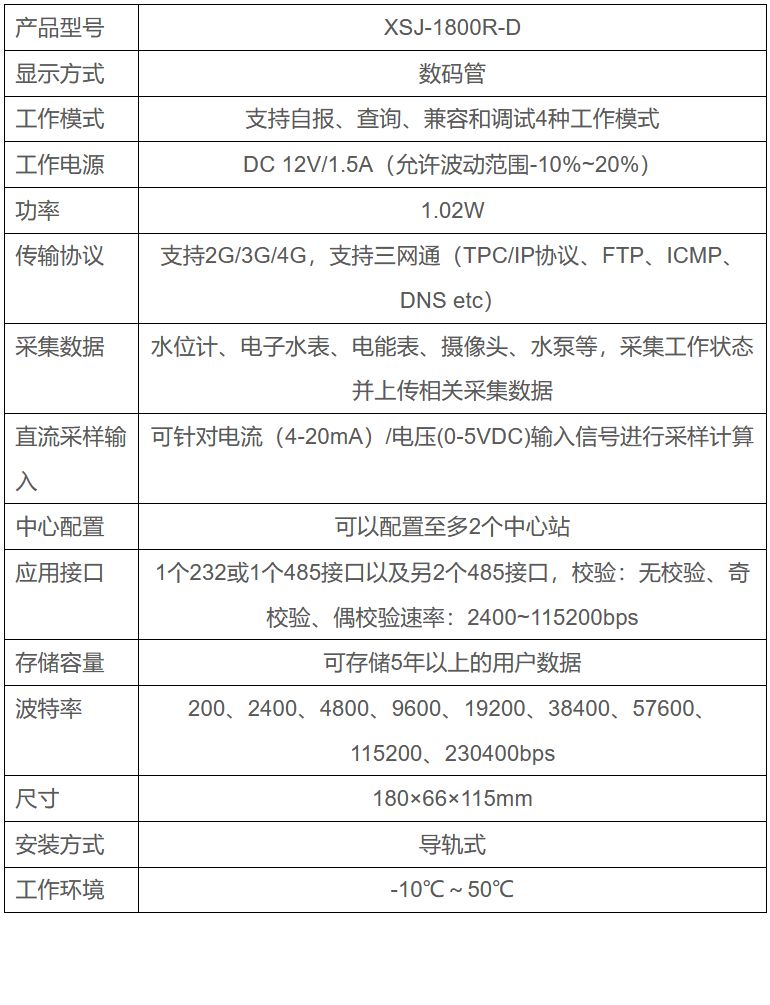Water Resource Measurement and Control Terminal
- Overview
- Main Features
- Main Indicators
- Main functions
- Device Configuration
The XSJ-1800R-D water resource measurement and control terminal is the core device within the water resource monitoring and management system, integrating traditional irrigation and drainage control terminal with 2G/3G/4G/LORA/GPS/Bluetooth communication transmission functions. It can connect to other devices to achieve functions such as irrigation water extraction, water level, and water quality monitoring. It can be installed indoors or outdoors in a measurement and control terminal box and is widely used in fields such as water-saving irrigation control, automatic pump and valve control, and agricultural water resource information management.
The XSJ-1800R-D remote measurement terminal product adopts a low-power design, making it particularly suitable for solar-powered field measurement stations, which can greatly reduce solar power supply costs and lower construction difficulty. It is widely used in industries such as hydrology, water conservancy, water affairs, meteorology, geology, and environmental protection.

1) Water quantity control management: It has early warning control for insufficient remaining water quantity on user cards.
2) Unified measurement and billing: It has water usage measurement, total irrigation water settlement, and achieves billing management.
3) Large capacity storage: It has a large capacity data storage space that can store user data for over 5 years without loss due to power outages.
4) Remote monitoring management: It has a connection management platform that allows remote viewing of water rights allocation management information; it can also view user water usage information, groundwater level changes, and monitor the site in real-time.
5) Multi-method parameter configuration: It has connection serial port configuration parameters, Mobile Bluetooth App configuration parameters, local manual configuration parameters, and remote platform configuration parameters.
6) Simple operation and maintenance: It has a three-phase power input and output connection method, controlling the power of the pump control cabinet, which is simple and reliable.

1) Data Collection: External instruments can be connected, such as water level gauges, electronic water meters, electric meters, cameras, water pumps, etc., to collect operational status and upload relevant collected data.
2) Terminal Alarm: Self-check the terminal's operational status, such as working voltage and other information; if limits are exceeded, feedback alarms will be given. External inspection of terminal-connected instruments and other equipment's operational status, such as water usage, water level, water pump, valve, box door, etc.; when limits are exceeded, the terminal will provide prompts.
3) Terminal Communication: Supports micro USB communication, external Modbus communication, 2G/3G/4G/LORA/Mobile App Bluetooth communication.
4) Remote Management: Supports connection to a remote management platform, allowing for terminal management control functions such as working mode, telemetry, data reporting, information querying, parameter configuration, remote upgrades, remote resets, and card-swiping restrictions.
5) Card Swiping: Supports swiping user cards (for water extraction) as well as customized management cards (for meter reading), setting cards (for parameter configuration), and zeroing cards (to clear user information) for related operations.
6) Local Storage: Locally loops and stores terminal data (user information, configuration information), not lost during power outages, with each terminal capable of storing data for up to 20 users (each user can extract water from a maximum of 10 terminals).
7) Central Station Configuration: Can configure up to 2 central stations.
8) Control Water Pumps or Valves: Based on the power of the on-site water pump, options can be selected for AC contactors, soft starters, and frequency converters to start and stop the water pump.

Previous:
The next one:


